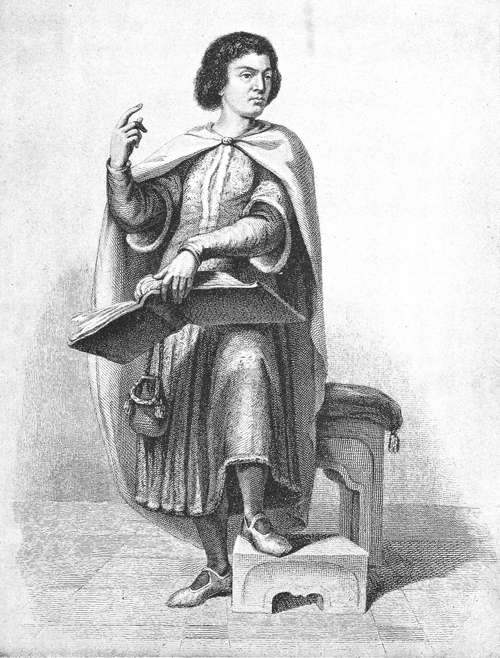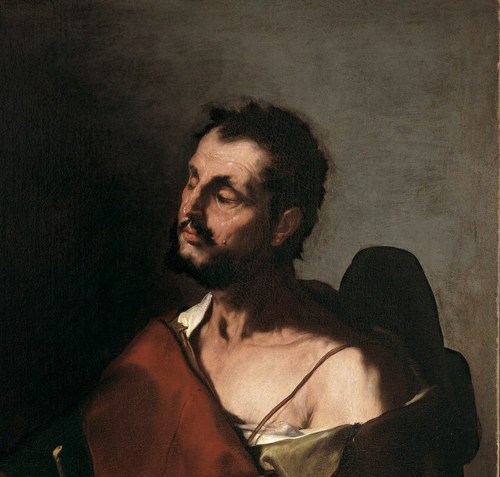
Your complimentary articles
You’ve read one of your four complimentary articles for this month.
You can read four articles free per month. To have complete access to the thousands of philosophy articles on this site, please
Articles
Abelard & Carneades: Yes & No
Frank Breslin says ‘yes and no’ to presenting both sides of an argument.
Should you have antiquarian interests, at some point you may want to read the medieval treatise Sic et Non written in 1120 by French theologian Peter Abelard (1079-1142 CE). It is a no-nonsense guide to critical thinking during the early Middle Ages. Merely reading its 158 theological questions would have been an education in itself for twelfth century university students, as within just a few minutes they would have discovered the kinds of questions that were routinely studied during that time.

Abelard
If they had been fortunate (that is, rich) enough to own a copy of this book before the age of printing, they could have chosen any question that interested them about God and Christianity, and found both pro and con arguments by authorities, that would at first glance have seemed equally convincing. What they wouldn’t have found, however, was a resolution of those questions, for that was the point of this groundbreaking, epoch-making, astonishing book. Students had to work their way through both sets of persuasive arguments to determine for themselves which arguments made the stronger case!
This personal challenge to each student caused a sensation in the medieval university world, which had always appealed to respected authorities and their proof texts to answer such questions. But here students were confronted with two sets of authorities that contradicted one another (hence the book’s title: Yes and No).
Abelard didn’t provide an answer key but purposely left his questions unanswered for two reasons: First, to dramatize the inadequacy of appealing to authority as a reliable means of answering questions. By juxtaposing contradictory arguments, students realized at once that appealing to authorities would have gotten them nowhere, for one set contradicted the other. In this sense, Sic et Non was a very iconoclastic book that shattered centuries of precedent. Second, to show that it was human reason alone that could settle these questions, by subjecting these pro and con arguments to critical analysis, to discover which side offered the more convincing case. Students had now to decide for themselves, not which authorities were right, but rather which offered the stronger arguments. This was a tectonic shift in attitude that said knowledge no longer had anything to do with prestige of an authority, but everything to do with the quality of argumentation and evidence. Welcome to the Modern World! For the first time in their lives, students were invited to leave intellectual childhood, where they had always been spoon-fed the ‘answers’, to become adults by choosing for themselves which arguments were the more convincing.
This newfound reliance on reason instead of authority brushed aside centuries of conditioning on the primacy of authority over reason in seeking truth – an idea which received its classic expression from Tertullian in the early third century: Quid ergo Athenis et Hierosolymis? Quid academiae et ecclesiae? – ‘What has Athens to do with Jerusalem? The Academy with the Church?’ (On the Prescription of Heretics, c.200 CE). Tertullian was rejecting the relevance of Greek philosophy to Christianity, which had its beginning in Jerusalem. For him divine revelation rather than human reason (as symbolized by Plato’s Academy in Athens) was the reliable way to truth. And now, one millennium later, Tertullian’s point of view was being challenged by the use of reason, not to deny revelation, but to determine what revelation had actually said; or, as Abelard himself wrote in his Prologue to Sic et Non: “Dubitando quippe ad inquisitionem uenimus; inquirendo ueritatem percipimus”: “By doubting we come to questioning; and through questions we perceive the truth”. So in one sense Sic et Non was not an iconoclastic book at all, but quite traditional in nature: it wasn’t denying divine revelation, but questioning revelation’s interpretation by various authorities, mainly early Church Fathers. Indeed, in his six thousand word Prologue, Abelard goes to great lengths in offering examples to suggest how critical intelligence could, in fact, reconcile some of their supposedly ‘contradictory’ arguments. So what we can say is that Abelard’s was a very subtle and sophisticated mind that wanted to engage the religious tradition in much more nuanced ways than had been done before. One comes away from reading the Prologue realizing that Abelard was no destroyer of traditional authority at all, but, on the contrary, its staunch defender, in a way that his critics might not perhaps have had the wit to understand. In fact, he comes across as the Church Fathers’ defense attorney, giving all sorts of possible reasons why they might have been misunderstood, as well as providing extenuating circumstances that would mitigate their errors.
This was nevertheless a revolution in medieval thinking; and once word began to spread about what Abelard was doing, students came flocking to Paris from all over Europe to study with this exciting new master of dialectical thinking. And the initial opposition to Abelard on the part of the older generation of churchmen gradually subsided over the coming decades, as the critics gradually died off and were replaced by the next generation, many of whom had once been Abelard’s students. His dialectical way of thinking became a feature of later Scholasticism, especially in the work of Thomas Aquinas (1225-75), as well as in later philosophy, up to our own times.
But, alas, nothing is permanent in this world, and Abelard’s Sic et Non was later considered so dangerous by Catholic authorities that it was placed on its Index Librorum Prohibitorum. Even in ecclesiastical circles, job security frequently prevails.

Carneades detail by Luca-Giordano 1658-60
Carneades
Abelard’s effect on his times bore a remarkable resemblance to that of the skeptical Greek philosopher Carneades (c. 214-129 BCE), who when he visited Rome also proceeded to argue both sides of an important question.
The Romans were always intrigued by the Greeks even before Carneades made his legendary visit in 155 BCE and created a sensation with his two-day lecture course. The first day he made a dazzling case for the noble cause of political justice, unleashing a barrage of seemingly irrefutable philosophical arguments why justice should be universally practiced by every tribe and nation – a performance that brought the audience of young Roman aristocrats to their feet in paroxysms of admiration. The very next day he returned, to demolish those seemingly irrefutable arguments. This implicitly justified all the actual Roman conquests and wanton depredations – to the great embarrassment of Cato the Censor and the other City Fathers also present at this event. Thus he showed the danger of the unfettered intellect for practical politics. Yet so dazzled by this second display of philosophical wizardry and oratorical skill were the young Roman audience, that they were beside themselves yet again. The news of what had just occurred spread like wildfire through the city, so that young men became eager to learn this rhetorical skill themselves.
Cato immediately drew two contradictory lessons from Carneades’ devastating performance: Should Romans want to demonstrate to all the world that theirs was indeed a just republic, they could do so by returning all the provinces they had unjustly annexed in earlier years. This, to be sure, would never occur. Should Romans choose not to do this, however, it would reveal to the world what moral hypocrites they were in preaching to other nations why they should at all times behave justly. Both these lessons made it clear that Carneades’ public ambush tore the mask of respectability from Rome’s serene public face, to reveal it as just another predatory nation, while preaching to the world the gospel of political justice. This alerted Cato to the terror of Greek learning: If young wealthy Romans were instructed in this new Greek logic, it could topple the Roman Republic itself by making plain the moral duplicity of what Rome had been doing for over a century (and would continue doing for centuries more). This unraveling of Rome’s visions for the future could never be allowed to happen; and so Carneades was banished from Rome the very next day.
Modern Comparisons
Today, if you read widely in any field, you also will discover that there are experts on every side of every question, so that one must simply choose which experts are the most persuasive – which is precisely what Abelard taught. This approach strikes the modern mind as commonsensical; but in twelfth century Europe it was almost heresy.
A more modern critical read is John Stuart Mill’s On Liberty (1859), which deals with pro and con arguments over censorship and freedom of thought throughout history. Its eloquence and argumentative power made it a masterpiece. However, you should not simply believe one word of that marvelous book, or the attempts to refute it, but keep an open mind and decide for yourself.
© Frank Breslin 2024
Frank Breslin is retired from the New Jersey public school system, where he taught English, Latin, German, and social studies for forty years.









